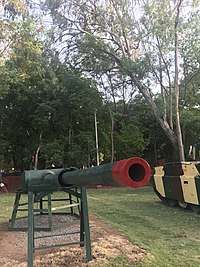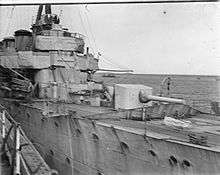BL 5.5-inch Mk I naval gun
The Breech Loading 5.5-inch Mk I was a naval gun used by the British Royal Navy during both World Wars.
| BL 5.5-inch Mark I | |
|---|---|
 | |
| Type | Naval gun, Coastal defence |
| Place of origin | United Kingdom |
| Service history | |
| In service | 1913–1954 |
| Wars | World War One World War Two |
| Production history | |
| Designer | Coventry Ordnance Works |
| Designed | 1913 |
| Manufacturer | Coventry Ordnance Works |
| No. built | 81 |
| Specifications | |
| Mass | 13,955 lbs (6,330 kg)[2] |
| Length | 6.985 metres (275.0 in) bore (50 cal) |
| Shell | 82 pounds (37.19 kg) |
| Calibre | 5.5-inch (140 mm) |
| Breech | Welin breech block with Holmstrom mechanism[3] |
| Elevation | -7 degrees to +30 degrees depending on mount[2] |
| Rate of fire | 12 rounds per minute |
| Muzzle velocity | 2,790 f/s (850 m/s)[2] |
| Effective firing range | 16,250 m at 30-degree elevation |
Naval history

This weapon was developed by Coventry Ordnance Works in 1913 and offered to the Greek Navy as the main armament for two new cruisers building at Cammell Laird. On the outbreak Of World War I the two ships were purchased by Britain as HMS Chester and HMS Birkenhead. The RN was happy with the performance of the gun as it was significantly lighter than the standard 6 inch gun and fired an 82 lb shell rather than the 100 lb shell of the 6 inch weapon. It, therefore, had a higher rate of fire with little loss in hitting power. The British ordered more guns as secondary armament for HMS Furious and HMS Hood. A total of 81 guns were made and were used on the following ships: HMS Chester, HMS Birkenhead, HMS Furious, HMS Hood, and HMS Hermes.
Guns removed from Chester, Birkenhead and Furious were used to arm Armed Merchant cruisers: HMS Laurentic and HMS Montclare.
Coast defence gun
In 1940, the 5.5 inch guns were removed from HMS Hood in a refit. Two were installed in Hood Battery on Ascension Island and remain there today. A pair were installed in specially built casemates on the roof of Coalhouse Fort in Essex, overlooking the Thames.[4] Guns from the Hood also went to Bognor Regis, Pevensey, North Foreland, Dover and Folkestone.[5]
Notable actions

Boy Seaman First Class Jack Cornwell was posthumously awarded the Victoria Cross for heroism in serving his gun on HMS Chester during the Battle of Jutland on 31 May 1916.
.jpg)
Surviving examples
- The gun served by Jack Cornwell VC is preserved in the Imperial War Museum in London.[1]
- Fort Bedford, Cross Hill, Ascension Island has two guns from HMS Hood
- Fort Skansin, Tórshavn, Streymoy Island, Faroe Islands, has two guns from HMS Furious
See also
Weapons of comparable role, performance and era
- Canon de 138 mm Modèle 1910 Naval gun : French equivalent
- 14 cm/50 3rd Year Type naval gun : Japanese equivalent
Notes
- Imperial War Museum (2012). "Naval BL 5.5 in Mk I Gun with Mk I pedestal mount". Imperial War Museum Collections Search. Retrieved 6 February 2012.
- Campbell, Naval Weapons of WWII, p.40.
- Di Giulian
- English Heritage (2008). "PastScape: Coalhouse Fort". National Monuments Record: PastScape. English Heritage. Archived from the original on 2 November 2013. Retrieved 10 February 2012.
- HMS Hood Association (4 April 2010). "HMS Hood Technical Specifications & Armament Information: Secondary/Dual Purpose Guns". Retrieved 10 February 2012.
References
- Tony DiGiulian, British 5.5"/50 (14 cm) BL Mark I
Bibliography
- Campbell, John (1985). Naval Weapons of World War Two. Naval Institute Press. ISBN 0-87021-459-4.
External links
| Wikimedia Commons has media related to BL 5.5 inch /50 naval gun. |